From Perceived Values to Shared Values: A Multi-Stakeholder Spatial Decision Analysis (M-SSDA) for Resilient Landscapes
Abstract
:1. Introduction
1.1. Case Study
2. Materials and Methods
- -
- Exploring, identifies and finds a group of local stakeholders to work with so as to achieve shared objectives.
- -
- Co-Designing, develops and designs with specific groups of citizens the transformations that could meet their needs, demands, and expectations.
- -
- Testing, tries, with local actors, new ways of promoting the landscape and implementing micro-actions which are useful in testing modalities to enhance and manage local resources.
- -
- Co-Evaluating, increases the knowledge of the landscape values on which the micro-actions of transformation should be based.
- Setting up survey tools: Setting up the survey with in-depth interviews, in accordance with the Cultural Values Model [54] to collect soft-data related to landscape perceptions for two selected groups of people (insiders and outsiders).
- Processing of soft investigations: Processing soft-data through the Semantic Analysis of the in-depth interviews obtained by the survey [55] to get relevant subjective indicators related to landscape perception and the place names where the interviewees identified their own factors of value.
- Setting spatial representation model: Recording on a Geographic Information System (GIS) the information supplied by the respondents (favourite place names and their relative weight), analysis, and mapping of the perceived landscape.
- Elaborating thematic maps: Making new thematic routes within the Park considering the results of previous steps and connecting the places of value identified by insiders and outsiders. This stage employs as well the Geo-Statistical techniques of GIS tools.
2.1. Setting up Survey Tools: The Cultural Values Model Approach
- -
- Insiders: People who live, work, or have their roots in a given context, and express an internal point of view, which is the result of collective knowledge.
- -
- Outsiders: Visitors, tourists, or researchers, and offer a different perspective on the same context.
2.1.1. The Identification of Survey Questions
- What is important for you in this landscape? Why?
- Which feelings do you link to these features?
- In which places within the Park do you find them?
- Are they important places for your life? Or for your community? Why?
- Would you recommend visiting them? Why?
- Is there any route that you would suggest? To who?
- When would be the best time to visit the park?
- Could you find a motto to sum up your way of living and to promote the Park?
2.1.2. The Selection of Interviewees
- -
- The first step involved identifying local stakeholders that promote the Park in alternative ways, beyond the traditional forms of tourism, which have resulted in land consumption, speculation, and the loss of local identity.
- -
- Thereafter, as per their participation in local events, the insiders and the outsiders were found for the quality survey on the landscape.
2.2. Processing of Soft Investigations: From Perceived Values to Shared Values
2.3. Setting Spatial Representation Model and Elaborating Thematic Maps
- -
- Weight 1, when low importance was given to a certain location by the respondent.
- -
- Weight 2, when average importance was given to a certain location by the respondent.
- -
- Weight 3, when high importance was given to a certain location by the respondent.
- -
- Group A identifies one or more areas of equal importance;
- -
- Group B identifies a major area with satellite areas;
- -
- Group C identifies a continuous path;
- -
- Group D identifies a wide portion of the landscape.
3. Results of the Co-Evaluation Phase
3.1. Intermediate Results
- -
- Among the insiders, those who prefer the Nature and Identity Routes belong to Groups A and B, while those who prefer the Well-being and Discovery Routes belong to Groups C and D.
- -
- Among the outsiders, those who prefer the Nature and Well-being Route belong to Groups A and B, while those who prefer the Discovery Route belong to Group D.
3.2. The Routes
4. Discussion and Conclusions
Acknowledgments
Author Contributions
Conflicts of Interest
References
- Local Governments for Sustainability (ICLEI). Resilient Cities 2012. In Congress Report, Proceedings of the 3rd Global Forum on Urban Resilience and Adaptation, Bonn, Germany, 12–15 May 2012; ICLEI: Bonn, Germany, 2012. [Google Scholar]
- ICLEI. Resilient Cities Report 2016. In Global Developments in Urban Adaptation and Resilience, Proceedings of the 7th Global Forum on Urban Resilience and Adaptation, Bonn, Germany, 6–8 July 2016; ICLEI: Bonn, Germany, 2016. [Google Scholar]
- Holling, C.S. Resilience and stability of ecological systems. Ann. Rev. Ecol. Syst. 1973, 4, 1–23. Available online: http://www.jstor.org/stable/2096802 (accessed on 31 January 2017).
- Gunderson, L.H. Ecological Resilience. In Theory and Application. Ann. Rev. Ecol. Syst. 2000, 31, 425–439. [Google Scholar] [CrossRef]
- Walker, B.H.; Salt, D. Resilience Thinking: Sustaining Ecosystems and People in a Changing World; Island Press: Washington, DC, USA, 2006. [Google Scholar]
- Beller, E.; Robinson, A.; Grossinger, R.; Grenier, L. Landscape Resilience Framework: Operationalizing Ecological Resilience at the Landscape Scale; Prepared for Google Ecology Program. A Report of SFEI-ASC’s Resilient Landscapes Program, Publication 752; San Francisco Estuary Institute: Richmond, CA, USA, 2015. [Google Scholar]
- Costanza, R.; Waigner, L.; Folke, C.; Mäler, K.-G. Modeling complex ecological economic systems: Towards an evolutionary dynamic understanding of people and nature. BioScience 1993, 43, 345–555. [Google Scholar] [CrossRef]
- Folke, C.; Carpenter, S.; Elmqvist, T.; Gunderson, L.; Holling, C.S.; Walker, B. Resilience and Sustainable Development: Building Adaptive Capacity in a World of Transformations. Ambio 2002, 31, 437–440. [Google Scholar] [CrossRef] [PubMed]
- Folke, C.; Carpenter, S.; Walker, B.; Scheffer, M.; Chapin, T.; Rockstrom, J. Resilience thinking: Integrating resilience, adaptability and transformability. Ecol. Soc. 2010, 15, 20–28. Available online: http://www.ecologyandsociety.org/vol15/iss4/art20/ (accessed on 30 January 2017).
- Otto-Zimmermann, K. Resilient Cities. Cities and Adaptation to Climate Change. Proceedings of the Global Forum 2010; Springer: Dordrecht, The Netherlands, 2011. [Google Scholar]
- Walker, B.H.; Holling, C.S.; Carpenter, S.R.; Kinzig, A. Resilience, adaptability and transformability in social-ecological systems. Ecol. Soc. 2004, 9, 1–9. Available online: http://www.ecologyandsociety.org/vol9/iss2/art5/. (accessed on 30 January 2017).
- Pigram, J.J.; Wahab, S. Tourism, Development and Growth: The Challenge of Sustainability; Routledge: London, UK; New York, NY, USA, 1997. [Google Scholar]
- Hall, C.M.; Lew, A.A. Understanding and Managing Tourism Impacts: An Integrated Approach; Routledge: London, UK, 2009. [Google Scholar]
- Briedenhann, J.; Wickens, E. Tourism routes as a tool for the economic development of rural areas—Vibrant hope or impossible dream? Tour. Manag. 2004, 25, 71–79. [Google Scholar] [CrossRef]
- Coccossis, H.; Mexa, A. The Challenge of Tourism Carrying Capacity Assessment: Theory and Practice; Ashgate: Aldershot, UK, 2004. [Google Scholar]
- Fusco Girard, L.; Nijkamp, P. Cultural Tourism and Sustainable Local Development; Ashgate: Aldershot, UK, 2009. [Google Scholar]
- Sonkoly, G. Historical Urban Landscape; Springer: Cham, Switzerland, 2017. [Google Scholar]
- The World Trade Organization (WTO). Tourism’s Potential as A Sustainable Development Strategy; World Tourism Organization: Madrid, Spain, 2005. [Google Scholar]
- Lone, S.; Lone, F.A.; Malik, A. Carrying capacity assessment for the promotion of ecotourism in Bangus Valley: A future tourist destination of J&K-India. Int. J. Sci. Res. 2013, 2, 187–188. [Google Scholar]
- Salerno, F.; Viviano, G.; Manfredi, E.C.; Caroli, P.; Thakuri, S.; Tartari, G. Multiple carrying capacities from a management-oriented perspective to operationalize sustainable tourism in protected areas. J. Environ. Manag. 2013, 128, 116–125. [Google Scholar] [CrossRef] [PubMed]
- Bera, S.; Das Majumdar, D.; Kumar Paul, A. Estimation of Tourism Carrying Capacity for Neil Island, South Andaman, India. J. Coast. Sci. 2015, 2, 46–53. [Google Scholar]
- Malik, M.I.; Bhat, M.S. Sustainability of tourism development in Kashmir—Is paradise lost? Tour. Manag. Perspect. 2015, 16, 11–21. [Google Scholar] [CrossRef]
- Plieninger, T.; Bieling, C. Resilience and the Cultural Landscape. Understanding and Managing Change in Human-Shaped Environments; Cambridge University Press: New York, NY, USA, 2012. [Google Scholar]
- United Nations Development Programme. Communities in Action for Landscape Resilience and Sustainability—The COMDEKS Programme; UNDP: New York, NY, USA, 2014. [Google Scholar]
- Berkes, F.; Folke, C. Linking Social and Ecological Systems: Management Practices and Social Mechanisms for Building Resilience; Cambridge University Press: Cambridge, UK, 1998. [Google Scholar]
- Carpenter, S.R.; Westley, F.; Turner, G. Surrogates for resilience of social–ecological systems. Ecosystems 2005, 8, 941–944. [Google Scholar] [CrossRef]
- Simmie, J.; Martin, R. The economic resilience of regions: Towards an evolutionary approach. Camb. J. Reg. Econ. Soc. 2010, 3, 27–43. [Google Scholar] [CrossRef]
- Davoudi, S.; Shaw, K.; Jamila Haider, L.; Quinlan, A.E.; Peterson, G.D.; Wilkinson, C.; Fünfgeld, H.; McEvoy, D.; Porter, L. Resilience: A Bridging Concept or a Dead End? “Reframing” Resilience: Challenges for Planning Theory and Practice Interacting Traps: Resilience Assessment of a Pasture Management System in Northern Afghanistan Urban Resilience: What Does it Mean in Planning Practice? Resilience as a Useful Concept for Climate Change Adaptation? The Politics of Resilience for Planning: A Cautionary Note. Plan. Theory Pract. 2012, 13, 299–333. [Google Scholar]
- The United Nations Educational, Scientific and Cultural Organization (UNESCO). Recommendation on the Historic Urban Landscape; Annex: Paris, France, 2011. [Google Scholar]
- Pelling, M. Adaptation to Climate Change, from Resilience to Transformation; Routledge: London, UK; New York, NY, USA, 2010; ISBN 978 0 415 477505. [Google Scholar]
- Verde, A. Resilient Landscapes. From spontaneous adaptation to a post-industrial planned multi-scalar resilience. In Resilient Cities 2013: Congress Report, ICLEI, Proceedings of the 4th Global Forum on Urban Resilience and Adaptation, Bonn, Germany, 31 May–2 June 2013; ICLEI: Bonn, Germany, 2013; pp. 1–17. [Google Scholar]
- Van Kamp, I.; Leidelmeijer, K.; Marsman, G.; De Hollander, A. Urban environmental quality and human well-being. Towards a conceptual framework and demarcation of concepts: A literature study. Landsc. Urban Plan. 2003, 65, 5–18. [Google Scholar]
- Kenter, J.O.; Reed, M.S.; Everard, M.; Irvine, K.N.; O’Brien, E.; Molloy, C.; Bryce, R.; Brady, E.; Christie, M.; Church, A.; et al. Shared, Plural and Cultural Values: A Handbook for Decision-Makers. In UK National Ecosystem Assessment Follow-On Phase; UNEP-WCMC: Cambridge, UK, 2014. [Google Scholar]
- Kenter, J.O.; Reed, M.S.; Irvine, K.N.; O’Brien, E.; Brady, E.; Bryce, R.; Christie, M.; Church, A.; Cooper, N.; Davies, A.; et al. Shared, Plural and Cultural Values of Ecosystems. In UK National Ecosystem Assessment Follow-On Work Package Report 6; UNEP-WCMC: Cambridge, UK, 2014. [Google Scholar]
- Council of Europe. European Landscape Convention, Florence, 20.X.2000. European Treaty Series—No. 176. Available online: http://www.coe.int/en/web/conventions/full-list/-/conventions/treaty/176 (accessed on 30 January 2017).
- Council of Europe. Council of Europe Framework Convention on the Value of Cultural Heritage for Society, Faro, 27.X.2005. Council of Europe Treaty Series—No. 199. Available online: http://www.coe.int/en/web/conventions/full-list/-/conventions/treaty/199 (accessed on 30 January 2017).
- Goosen, M.; Langers, F. Assessing quality of rural areas in the Netherlands: Finding the most important indicators for recreation. Landsc. Urban Plan. 2000, 46, 241–251. [Google Scholar] [CrossRef]
- Veenhoven, V. Subjective measures of well-being. In Human Well-Being Concept and Measurement; McGillivray, M., Ed.; Palgrave/McMillan: Houndmills, NH, USA, 2007; pp. 214–239. [Google Scholar]
- Cassatella, C.; Peano, A. Landscape Indicators: Assessing and Monitoring Landscape Quality; Springer: Dordrecht, The Netherlands, 2011. [Google Scholar]
- UNU-IAS; Bioversity International; IGES; UNDP. Toolkit for the Indicators of Resilience in Socio-Ecological Production Landscapes and Seascapes (SEPLS). 2014. Available online: https://comdeksproject.files.wordpress.com/2014/11/toolkit-indicators-web.pdf (accessed on 30 January 2017).
- Lawrence, R.J. Human ecology and its applications. Landsc. Urban Plan. 2003, 65, 31–40. [Google Scholar] [CrossRef]
- Rammstedt, B. Subjective Indicators. RatSWD Work. Pap. Ser. 2009, 119, 1–10. [Google Scholar] [CrossRef]
- Organization for Economic Co-operation and Development (OECD). How's Life? 2015. Measuring Well-Being; OECD Publishing: Paris, France, 2015. [Google Scholar]
- Department of Economic and Social Affairs (DESA). The Sustainable Development Goals Report 2016; UN: New York, NY, USA, 2016. [Google Scholar]
- Pacione, M. Urban environmental quality and human wellbeing—A social geographical perspective. Landsc. Urban Plan. 2003, 65, 19–30. Available online: http://www.sciencedirect.com/science/article/pii/S0169204602002347 (accessed on 30 January 2017).
- Cerreta, M.; Fusco Girard, L. Human Smart Landscape: An Adaptive and Synergistic Approach for the “National Park of Cilento, Vallo di Diano and Alburni”. Agric. Agric. Sci. Procedia 2016, 8, 489–493. [Google Scholar] [CrossRef]
- Irvine, K.; O’Brien, L.; Ravenscroft, N.; Cooper, N.; Everard, M.; Fazey, I.; Reed, M.; Kenter, J.O. Ecosystem services and the idea of shared values. Ecosyst. Serv. 2016, 21, 184–193. [Google Scholar] [CrossRef]
- Mash, J. Living Labs and Territorial Innovation. In Collaboration and the Knowledge Economy: Issues, Applications, Case Studies; Cunningham, P., Cunningham, M., Eds.; Ios Press: Amsterdam, The Netherlands, 2008. [Google Scholar]
- Ståhlbröst, A.; Holst, M. The Living Lab Methodology Handbook; Social Informatics at Luleå University of Technology and CDT, Centre for Distance-spanning Technology: Luleå, Sweden, 2012. [Google Scholar]
- D&Auria, A.; Ruocco, F. Paesaggio, Strategia, Identità. Pianificare il Cilento tra vocazione ed innovazione. Urban. Inf. 2007, 211, 61–62. [Google Scholar]
- ENoLL—European Network of Living Labs. Available online: http://www.openlivinglabs.eu/aboutus (accessed on 30 January 2017).
- Molinari, F. Overview of the Living Lab Approach. In Best Practices Database for Living Labs; Alcotra Innovation Project: Tourin, Itay, 2011; pp. 7–48. Available online: http://www.alcotra-innovation.eu/progetto/ (accessed on 30 January 2017).
- Concilio, G. Urban Living Labs: Opportunities in and for Planning. In Human Smart Cities. Rethinking the Interplay between Design and Planning; Concilio, G., Rizzo, F., Eds.; Springer: Heidelberg, Germany, 2016; pp. 21–40. [Google Scholar]
- Stephenson, J. The Cultural Values Model: An integrated approach to values in landscapes. Landsc. Urban Plan. 2008, 84, 127–139. Available online: http://www.sciencedirect.com/science/article/pii/S0169204607001661 (accessed on 30 January 2017). [CrossRef]
- Goddard, C. Semantic Analysis. A Practical Introduction, 2nd ed.; Oxford University Press: Oxford, UK, 2011. [Google Scholar]
- MacFarlane, R.; Haggett, C.; Fuller, D.; Dunsford, H.; Carlisle, B. Tranquillity Mapping: Developing A Robust Methodology for Planning Support; Report to the Campaign to Protect Rural England, Countryside Agency, North East Assembly, Northumberland Strategic Partnership, Northumberland National Park Authority and Durham County Council, Centre for Environmental & Spatial Analysis; Northumbria University: Newcastle Upon Tyne, UK, 2004. [Google Scholar]
- Djamel, F. Valuation Methods of Landscape. Int. J. Res. Methodol. Soc. Sci. 2016, 2, 36–44. [Google Scholar]
- Rappaport, A. Creating Shareholder Value. A Guide for Managers and Investors; The Free Press: New York, NY, USA, 1986. [Google Scholar]
- Mäenpää, M. The Importance of Shareholder Value in Decision-Making. In Business Economics; Vaasan Ammattikorkeakoulu: Vaasa, Finland, 2016; pp. 1–63. [Google Scholar]
- Jansson, A.M.; Hammer, M.; Folke, C.; Costanza, R. Investing in Natural Capital: The Ecological Economics Approach to Sustainability; Island Press: Washington, DC, USA, 1994. [Google Scholar]
- Costanza, R.; de Groot, R.; Sutton, P.; Van der Ploeg, S.; Anderson, S.J.; Kubiszewski, I.; Farber, S.; Turner, R.K. Changes in the global value of ecosystem services. Glob. Environ. Chang. 2014, 26, 152–158. [Google Scholar] [CrossRef]
- Sagoff, M. Values and preferences. Ethics 1986, 96, 301–316. [Google Scholar] [CrossRef]
- Kenter, J.O.; O’Brien, L.; Hockley, N.; Ravenscroft, N.; Fazey, I.; Irvine, K.N.; Reed, M.S.; Christie, M.; Brady, E.; Bryce, R.; et al. What are shared and social values of ecosystems? Ecol. Econ. 2015, 111, 86–99. [Google Scholar] [CrossRef]
- Kashyap, V.; Sivadas, E. An exploratory examination of shared values in channel relationships. J. Bus. Res. 2012, 65, 586–593. [Google Scholar] [CrossRef]
- Bocanet, A.; Ponsiglione, C. Balancing exploration and exploitation in complex environments. VINE 2012, 42, 15–35. [Google Scholar] [CrossRef]
- Van den Brink, A.; Bruns, D.; Tobi, H.; Bell, S. Research in Landscape Architecture: Methods and Methodology; Routledge: New York, NY, USA, 2017. [Google Scholar]
- Kaymaz, I.C. Landscape Perception. In Landscape Planning; Murat Ozyavuz, M., Ed.; InTech: Rijeka, Croatia, 2012; Available online: http://www.intechopen.com/books/landscape-planning/landscapeperception (accessed on 30 January 2017).
- Sutton, R.K. Ecology of Scale in Visual Landscape Assessments. In Landscape Architecture Program: Faculty Scholarly and Creative Activity; University of Nebraska-Lincoln: Lincolin, NE, USA, 2013; p. 17. [Google Scholar]
- Quantum GIS Development Team. Quantum GIS Development Team. Quantum GIS Geographic Information System. In Open Source Geospatial Foundation Project; Quantum GIS Development Team: Grüt, Switzerland, 2014. [Google Scholar]
- Bonifazi, A.; Sannicandro, V.; Attardi, R.; Di Cugno, G.; Torre, M.C. Countryside vs. City: A User-Centered Approach to Open Spatial Indicators of Urban Sprawl. In Proceedings of the International Conference on Computational Science and Its Applications, ICCSA2016, Beijing, China, 4–7 July 2016; pp. 161–176. [Google Scholar]
- Meini, M.; Nocera, R.; Spinelli, G. L’analisi spaziale della mobilità turistica attraverso strumenti di geotagging: Un esperimento con la web community di Panoramio. Boll. dell'Associazione Ital. di Cartogr. 2013, 149, 87–101. Available online: http://hdl.handle.net/10077/9940 (accessed on 30 January 2017).
- Zanon, S.; Luciani, D. Il concorso Luoghi di valore. In Proceedings of the International Conference Landscapes of Everyday Life. Intersecting Perspectives on Research and Action, Perpignan, France, 16–18 March 2011; Available online: http://www.fbsr.it/ (accessed on 12 March 2013).
- Murgante, B.; Danese, M. Urban versus rural: The decrease of agricultural areas and the development of urban zones analyzed with spatial statistics. Int. J. Agric. Environ. Inf. Syst. (IJAEIS) 2011, 2, 16–28. [Google Scholar] [CrossRef]
- Vizzari, M. Spatial modelling of potential landscape quality. Appl. Geogr. 2011, 31, 108–118. [Google Scholar] [CrossRef]
- Cressie, N.A.C.; Wikle, C.K. Statistics for Spatio-Temporal Data; Wiley: Hoboken, NJ, USA, 2011. [Google Scholar]
- Bruno, G. Atlante Delle Emozioni. In Viaggio Tra Arte, Architettura e Cinema, 1st ed.; Mondadori: Milano, Italy, 2002. [Google Scholar]
- Panaro, S. Landscape Co-Evaluation. Approcci Valutativi Adattivi per la Cocreatività Territoriale e l’innovazione Locale. Ph.D Thesis, University of Naples Federico II, Napoli, Italy, 2015. [Google Scholar]
- De Oliveira, À.D. The Human Smart Cities Manifesto: A Global Perspective. In Human Smart Cities, 1st ed.; Concilio, G., Rizzo, F., Eds.; Springer: Cham, Switzerland, 2016; pp. 197–202. [Google Scholar]
- Sacco, P.L.; Zamagni, S. Teoria Economica e Relazioni Interpersonali; Il Mulino: Bologna, Italy, 2006. [Google Scholar]
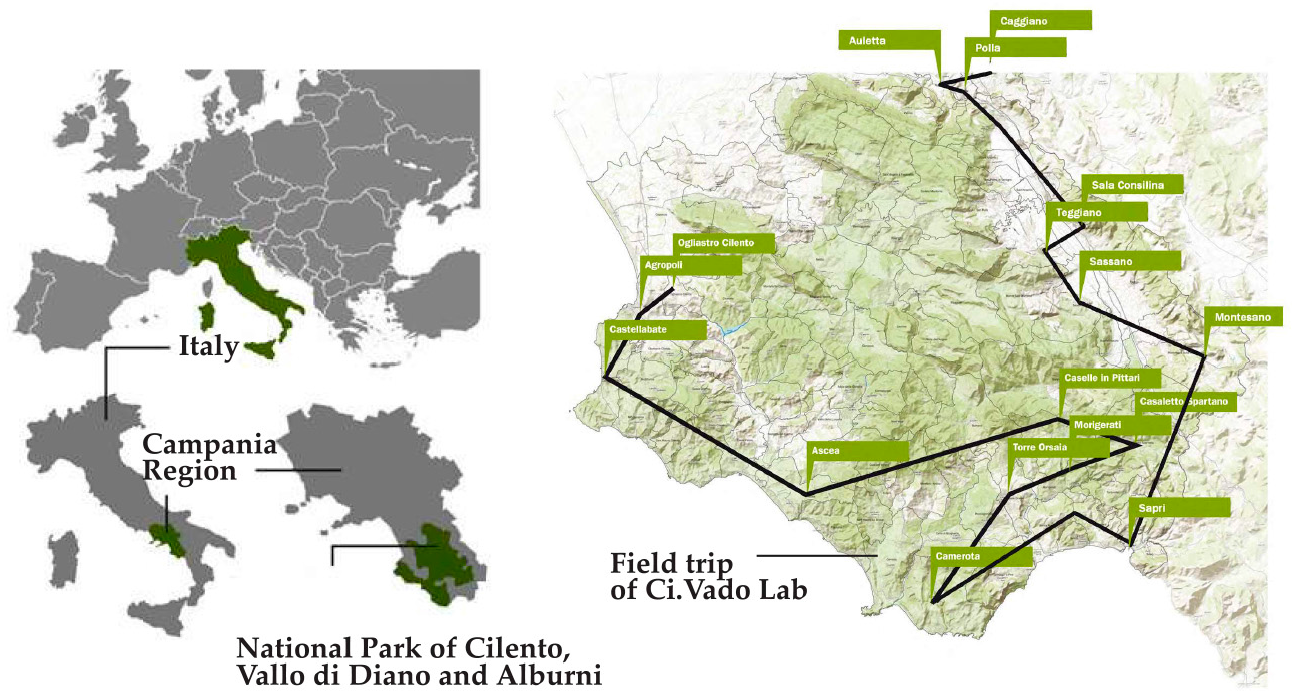
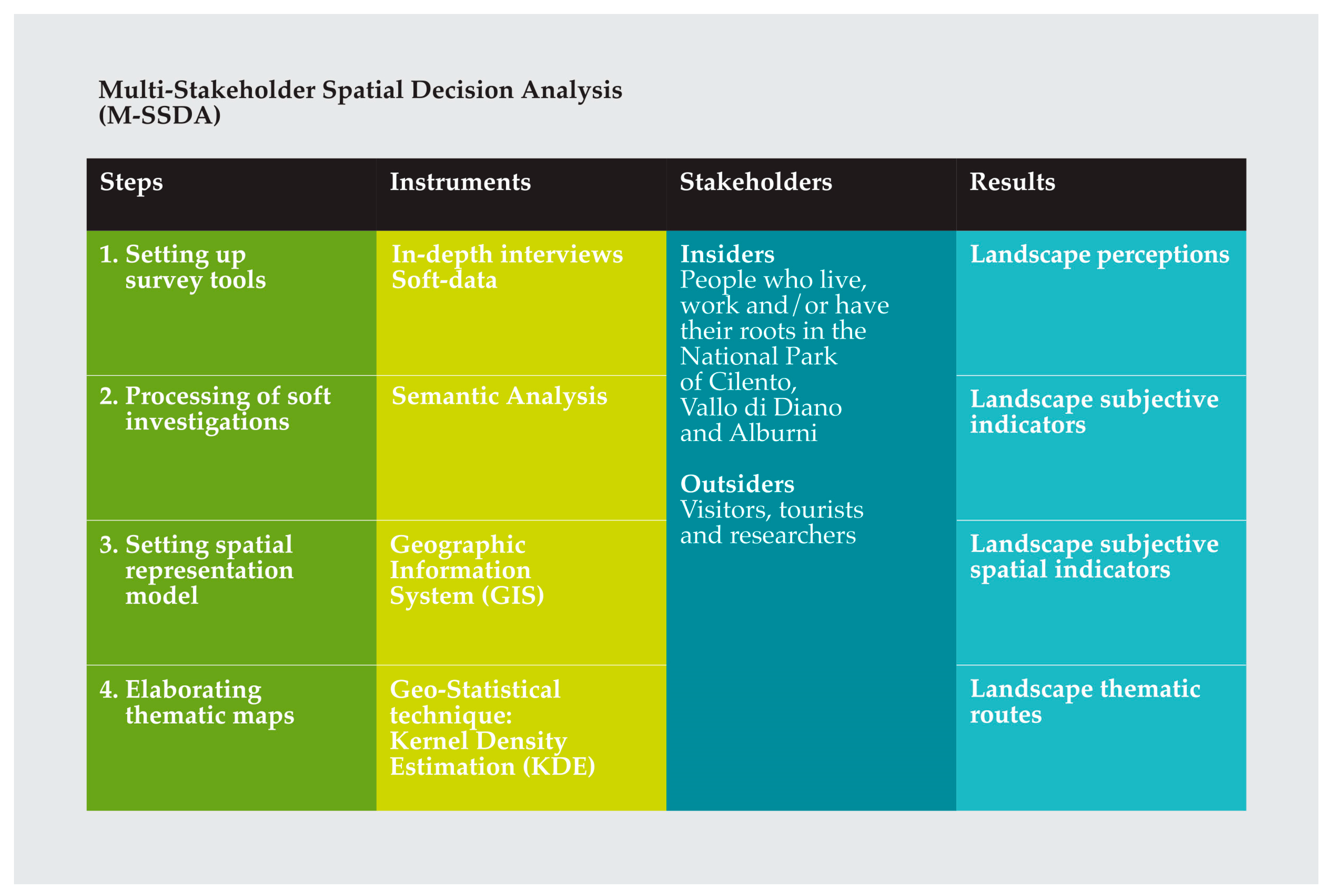


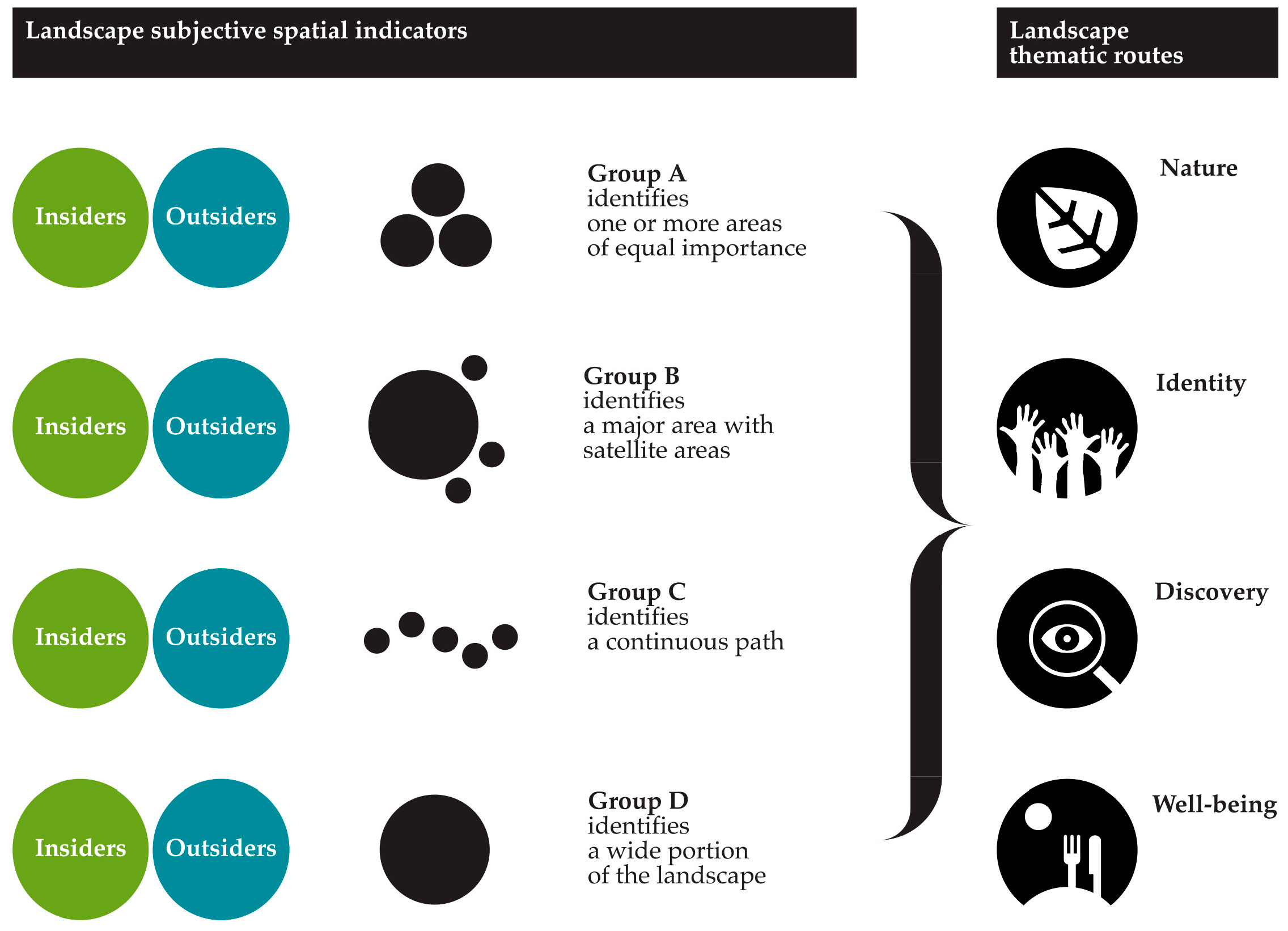

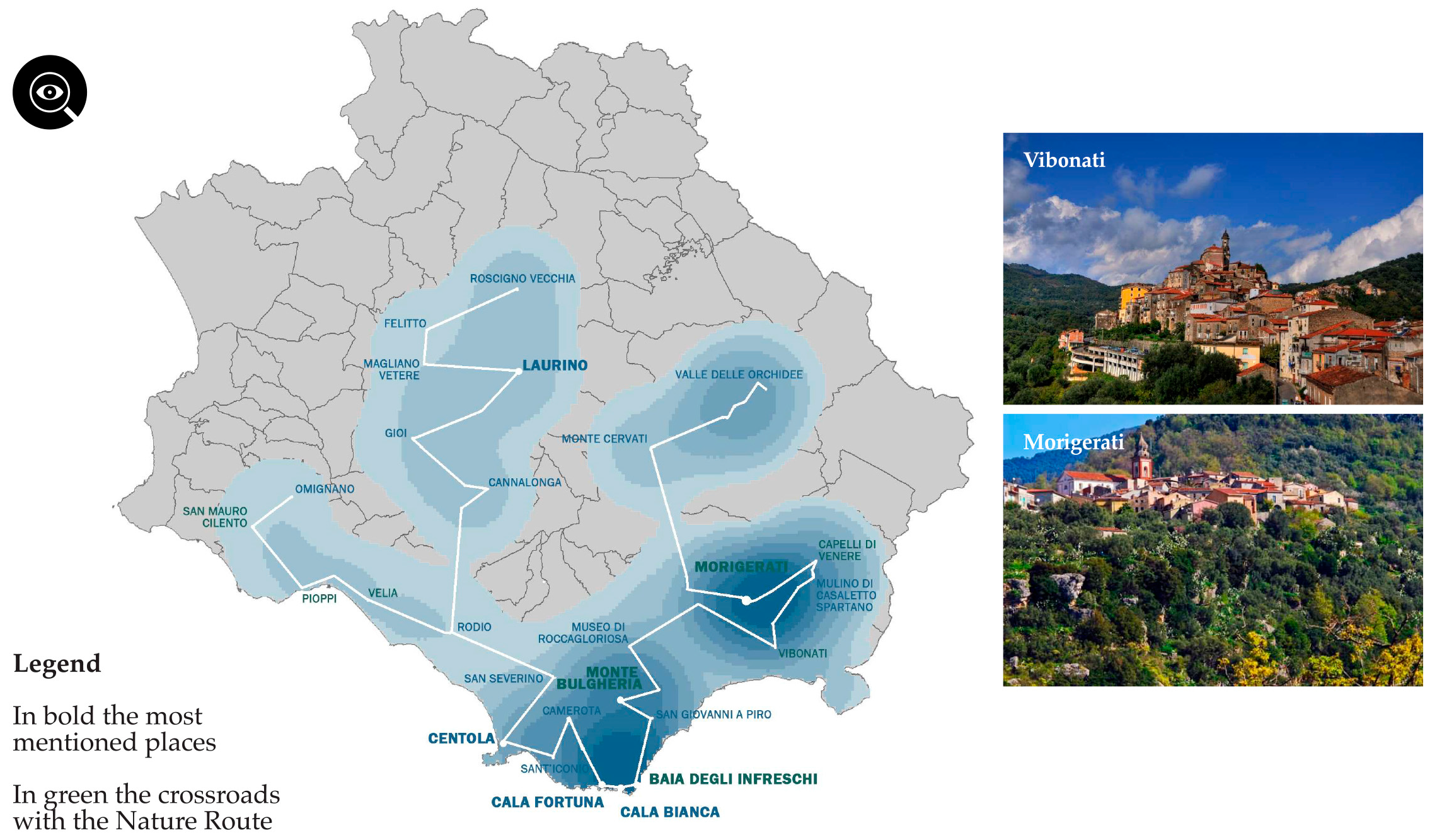
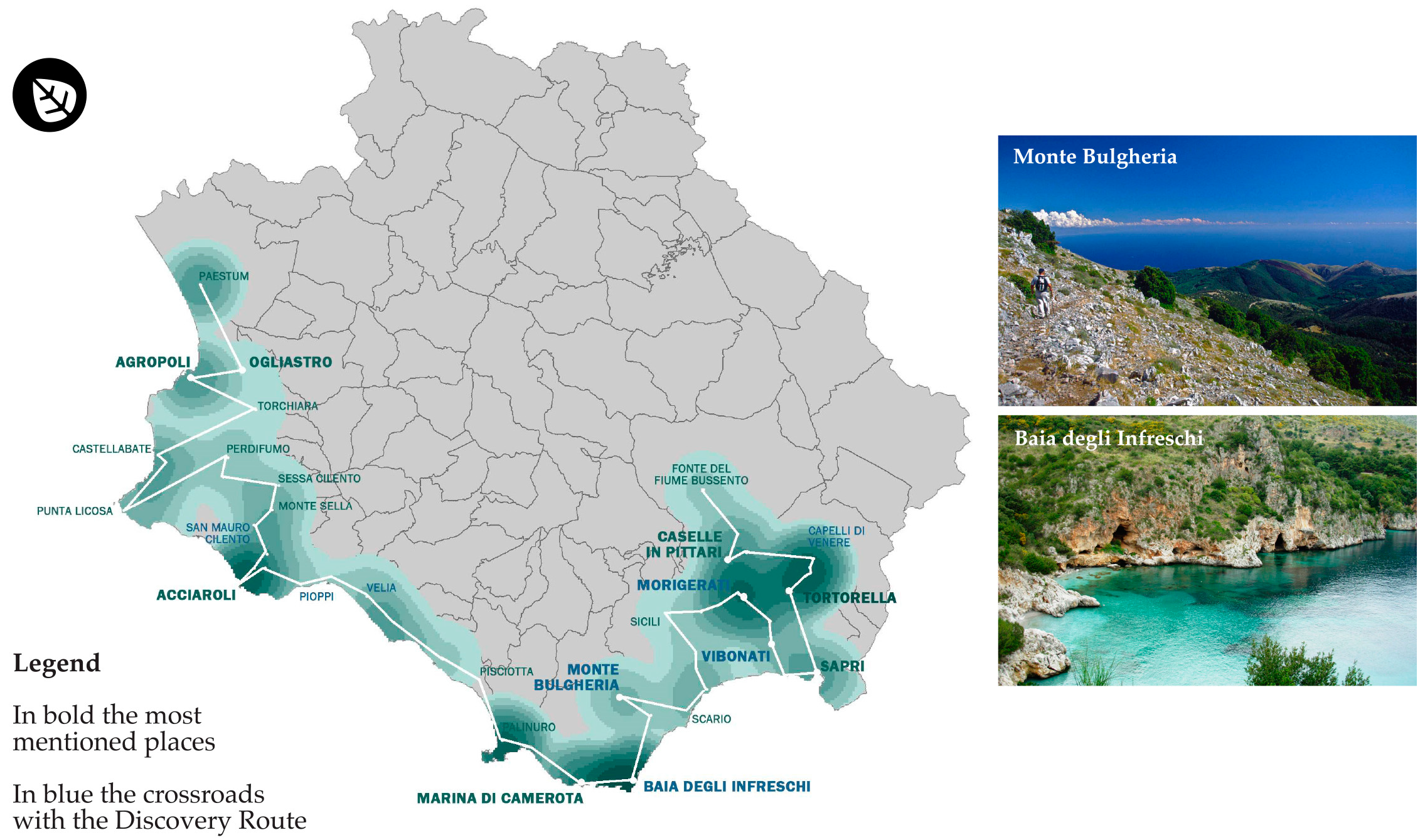
| Questions | Detected Data | Aims | Outputs |
|---|---|---|---|
| 1. What is important for you in this landscape? Why? | Key-words | Identifying the relevant tangible and intangible features of the Park landscape | Shared meanings and values of the landscape |
| 2. Which feelings do you link to these features? | Linked-words | Identifying the subjective meanings recognized to the features of the Park landscape | |
| 3. In which places within the Park do you find them? | Names of the places | Localizing the found features in the Park | Perceived qualities maps of the landscape |
| 4. Are they important places for your life? Or for your community? Why? | Relevance of the places | Attributing a weight to the places of the Park | |
| 5. Would you recommend visiting them? Why? | |||
| 6. Is there any route that you would suggest? To who? | Preferences for potential users | Identifying a specific route of the Park and its potentials users | Information for the landscape promotion |
| 7. When would be the best time to visit the Park? | Identifying a specific time to visit the Park suitable for users | ||
| 8. Could you find a motto to sum up your way of living and to promote the Park? | Identifying a way to communicate the Park and its opportunities |
| Semantic Field | Key-Words | Linked-Words |
|---|---|---|
| Discovery | Known | Culture |
| Hidden | Historic town | |
| In extinction | Towns in state of abandon | |
| Not well-known | Heritage | |
| Submerged | Water | |
| Subsoil | ||
| Local food | ||
| Local crafts and knowledge | ||
| Encounter | ||
| Landscape | ||
| Traditional holiday | ||
| Identity | Community relations | Landscape |
| Hospitality | ||
| Food | ||
| Well-being | Quality of life | Traditions |
| Tranquillity | Gastronomy | |
| Healthy life | Relaxation | |
| No crime | Sea | |
| Peaceful life | Hospitality | |
| Well-being | Landscape | |
| Involvement | Culture | |
| Find oneself | ||
| Recover the meaning of life | ||
| Recover your dreams | ||
| Peace within | ||
| Freedom | ||
| Nature | Nature | Uniqueness |
| Pristine | Natural oasis |
© 2017 by the authors. Licensee MDPI, Basel, Switzerland. This article is an open access article distributed under the terms and conditions of the Creative Commons Attribution (CC BY) license (http://creativecommons.org/licenses/by/4.0/).
Share and Cite
Cerreta, M.; Panaro, S. From Perceived Values to Shared Values: A Multi-Stakeholder Spatial Decision Analysis (M-SSDA) for Resilient Landscapes. Sustainability 2017, 9, 1113. https://doi.org/10.3390/su9071113
Cerreta M, Panaro S. From Perceived Values to Shared Values: A Multi-Stakeholder Spatial Decision Analysis (M-SSDA) for Resilient Landscapes. Sustainability. 2017; 9(7):1113. https://doi.org/10.3390/su9071113
Chicago/Turabian StyleCerreta, Maria, and Simona Panaro. 2017. "From Perceived Values to Shared Values: A Multi-Stakeholder Spatial Decision Analysis (M-SSDA) for Resilient Landscapes" Sustainability 9, no. 7: 1113. https://doi.org/10.3390/su9071113






